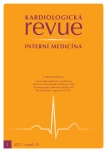Cardiotoxicity in haemato-oncological patients
Authors:
B. Mladosievičová
Authors‘ workplace:
Oddelenie klinickej patofyziológie, LF UK v Bratislave
Published in:
Kardiol Rev Int Med 2017, 19(1): 34-38
Overview
Novel therapeutic approaches have led to an improvement in the survival of patients with haematologic malignancies, however, this success often leads to unexpected acute, chronic and late adverse cardiovascular events. In the last decade, anti-cancer therapy-induced cardiotoxicity is associated mainly with targeted therapy, immunomodulatory agents, proteasome inhibitors and more recently also with immunotherapy. These treatment methods may be associated with left ventricular dysfunction, heart failure, coronary artery disease, including acute coronary syndrome, arterial hypertension, thromboembolic complications, peripheral artery disease, pulmonary hypertension, valvular defects as well as arrhythmias, occurring simultaneously with the treatment and rarely also after its termination. This mini-review presents a brief overview of cardiovascular issues induced by haemato-oncological therapy and discusses the pathomechanisms of cardiotoxicity and new clinical data regarding novel therapeutics.
Keywords:
targeted therapy – immunomodulatory drugs – proteasome inhibitors – immunotherapy – radiotherapy – cardiovascular complications
Sources
1. Zamorano JL, Lancellotti P, Rodriguez Muñoz D et al. ESC Committee for Practice Guidelines (CPG). 2016 ESC Position Paper on cancer treatments and cardiovascular toxicity developed under the auspices of the ESC Committee for Practice Guidelines: The Task Force for cancer treatments and cardiovascular toxicity of the European Society of Cardiology (ESC). Eur Heart J 2016; 37(36): 2768–2801.
2. Li W, Garcia D, Cornell RF et al. Cardiovascular and thrombotic complications of novel multiple myeloma therapies: a review. JAMA Oncol 2016. doi: 10.1001/ jamaoncol.2016.3350.
3. Kistler KD, Kalman J, Sahni G et al. Incidence and risk of cardiac events in patients with previously treated multiple myeloma versus matched patients without multiple myeloma: an observational, retrospective, cohort study. Clin Lymphoma Myeloma Leuk 2016. pii: S2152-2650(16)30872-2. doi: 10.1016/ j.clml.2016.11.009.
4. El Accaoui RN, Shamseddeen WA, Taher AT. Thalidomide and thrombosis: meta-analysis. Thromb Haemost 2007; 97(6): 1031–1036.
5. Li W, Cornell RF, Lenihan D et al. Cardiovascular complications of novel multiple myeloma treatment. Circulation 2016; 133(9): 908–912. doi: 10.1161/ CIRCULATIONAHA.115.018351.
6. Hiroi T, Deming CB, Zhao H et al. Proteasome inhibitors enhance endothelial thrombomodulin expression via induction of Krüppel-like transcription factors. Arterioscler Thromb Vasc Biol 2009; 29(10): 1587–1593. doi: 10.1161/ ATVBAHA.109.191957.
7. Nayak L, Shi H, Atkins GB et al. The thromboprotective effect of bortezomib is dependent on the transcription factor Kruppel-like factor 2 (KLF2). Blood 2014; 123(24): 3828–3831. doi: 10.1182/ blood-2014-01-547448.
8. Moslehi JJ. Cardiovascular toxic effects of targeted cancer therapies. N Engl J Med 2016; 375(15): 1457–1467.
9. Mladosievičová B a kol. Kardioonkologie. Praha: Grada Publishing 2014.
10. Herrmann J, Yang EH, Iliescu CA et al. Vascular toxicities of cancer therapies: the old and the new-an evolving avenue. Circulation 2016; 133(13): 1272–1289. doi: 10.1161/ CIRCULATIONAHA.115.018347.
11. Herrmann J. Tyrosine kinase inhibitors and vascular toxicity: impetus for a classification system? Curr Oncol Rep 2016; 18(6): 33. doi: 10.1007/ s11912-016-0514-0.
12. Iliescu CA, Grines CL, Herrmann J et al. SCAI Expert consensus statement: Evaluation, management, and special considerations of cardio-oncology patients in the cardiac catheterization laboratory. Catheter Cardiovasc Interv 2016; 87(5): E202–E223. doi: 10.1002/ ccd.26379.
13. Deeks ED. Ibrutinib: A review in chronic lymphocytic leukemia. Drugs 2017; 77(2): 225–236. doi: 10.1007/ s40265-017-0695-3.
14. Byrd JC, Brown JR, O'Brien S et al. RESONATE Investigators. Ibrutinib versus ofatumumab in previously treated chronic lymphoid leukemia. N Engl J Med 2014; 371(3): 213–223. doi: 10.1056/ NEJMoa1400376.
15. Byrd JC, Hillmen P, James DF. Additional data needed for a better understanding of the potential relationship between atrial fibrillation and ibrutinib. Blood 2015; 125(10): 1673. doi: 10.1182/ blood-2015-01-621466.
16. Cutter DJ, Schaapveld M, Darby SC et al. Risk for valvular heart disease after treatment for hodgkin lymphoma. J Natl Cancer Inst 2015; 107(4): djv008. doi: 10.1093/ jnci/ djv008.
17. Mladosievičová B, Hricák V. Kardiovaskulárne následky rádioterapie onkologického ochorenia – vieme si pomôcť. Kardiol Prax 2015; 13(2): 65–69.
18. Ng KH, Dearden C, Gruber P. Rituximab-induced Takotsubo syndrome: more cardiotoxic than it appears? BMJ Case Rep 2015; 2015. pii: bcr2014208203. doi: 10.1136/ bcr-2014-208203.
19. Heinzerling L, Ott PA, Hodi FS et al. Cardiotoxicity associated with CTLA4 and PD1 blocking immunotherapy. J Immunother Cancer 2016; 4: 50. doi: 10.1186/ s40425-016-0152-y.
20. Johnson DB, Balko JM, Compton ML et al. Fulminant myocarditis with combination immune checkpoint blockade. N Engl J Med 2016; 375(18): 1749–1755. doi: 10.1056/ NEJMoa1609214.
21. Moslehi JJ, Johnson DB, Sosman JA et al. Myocarditis with immune checkpoint blockade. N Engl J Med 2017; 376(3): 292. doi: 10.1056/ NEJMc1615251.
22. National Comprehensive Cancer Network Guidelines 2015, version 2.2015 Survivorship. Available from: http:/ / www.nccn.org/ professionals/ default.aspx.
Labels
Paediatric cardiology Internal medicine Cardiac surgery CardiologyArticle was published in
Cardiology Review

2017 Issue 1
Most read in this issue
- Diuretics and mineralocorticoid receptor antagonists in the therapy of chronic heart failure with reduced left ventricular ejection fraction
- COSYREL – a drug for patients with coronary artery disease and heart failure
- Rivaroxaban – pharmacological profile
- Late consequences of cardiotoxicity
